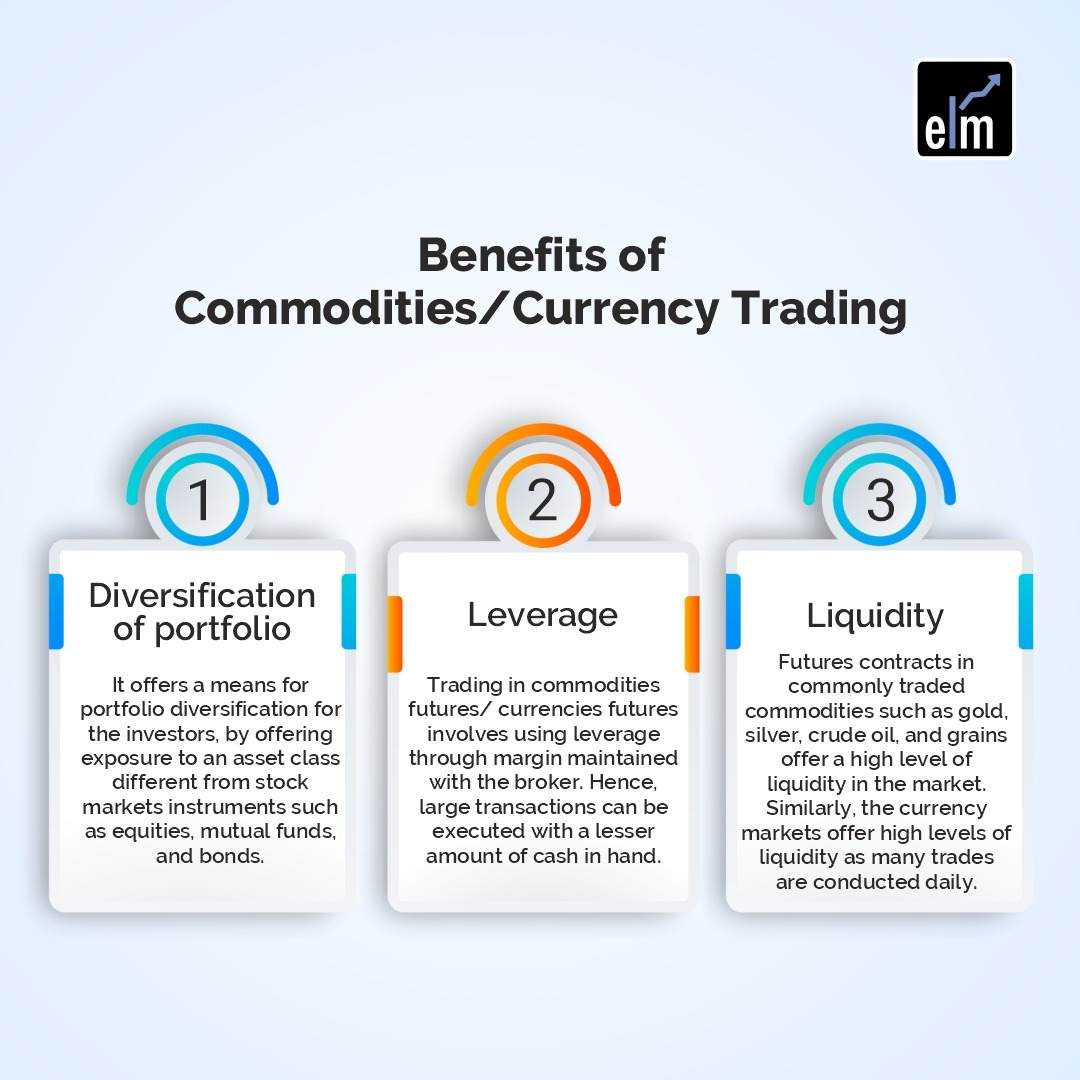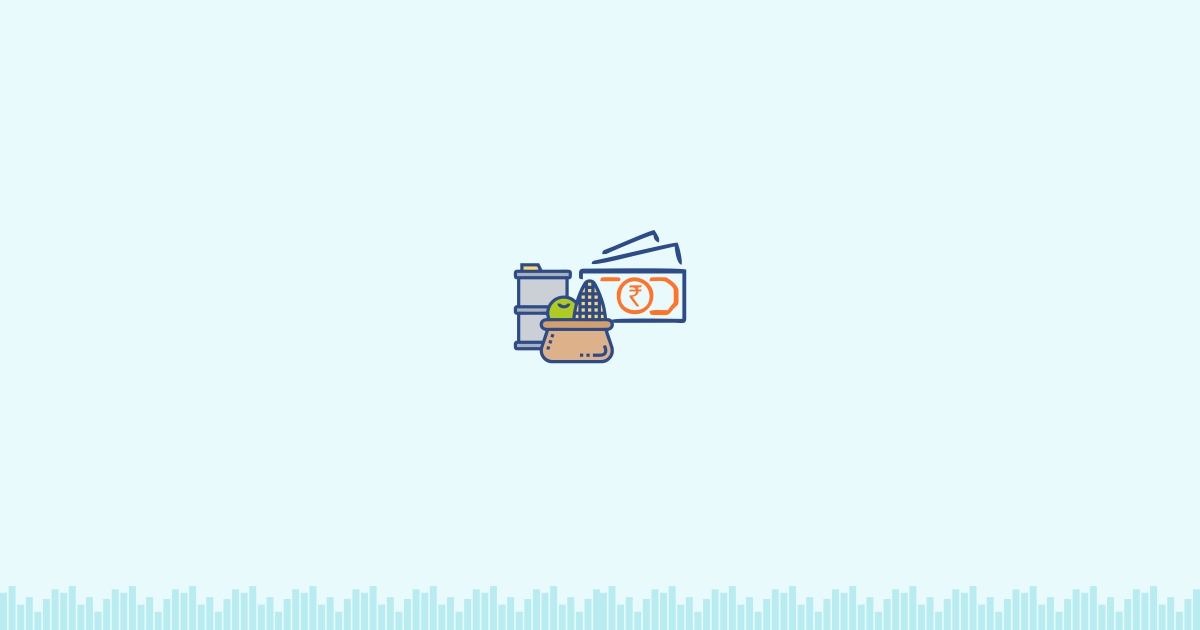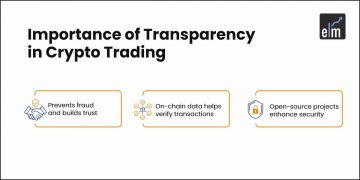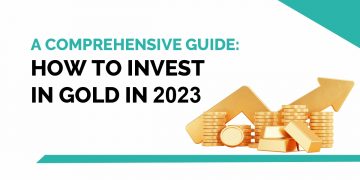Key Takeaways
- Market Drivers Matter: Commodity and currency prices are driven mainly by global supply-demand, macro trends, weather and geopolitics, not company-level news.
- Use Intermarket Analysis: Studying links between stocks, bonds, commodities, and currencies helps spot broader market direction and better trade setups.
- Crude & Gas Aren’t Identical: They can move together at times, but each responds to different fundamentals, so correlation is often weak.
- Know the Trading Process: In India, commodities trade via futures/options (not spot), while currency exposure is through currency futures and options on key pairs.
- Trading Benefits: These markets offer diversification, high liquidity, longer hours, leverage and global exposure, useful tools for active traders.
Trading in commodities involves trading in all forms of movable property, excluding money, securities, and actionable claims. These include certain agricultural products and gold, silver, and other metals. When two currencies are exchanged, they have different values, known as currency trading. It is a sizable market, with traded value exceeding equity. This is known as commodity and currency trading.
Over the past few years, the commodity and currency markets in India and worldwide have experienced tremendous growth. Although equity markets in India receive the majority of attention, the importance of the commodity and currency markets is frequently overlooked.
Contrary to current global trends, the trading and turnover on the currency and commodity markets is higher than that on the equity markets. Understanding the price behaviour of commodities is crucial and fascinating because of how closely they are related to our daily lives.
In today’s blog, let us discuss how to trade in currency and commodities:
What is Commodity and Currency Trading?
Every asset class has its dynamics in trading, so it’s critical to comprehend what influences price changes. In this sense, macroeconomic factors that affect supply and demand dominate the commodities and currency markets.
Contrary to equities, primarily influenced by fundamentals specific to a stock or industry, commodities are influenced by demand, supply, weather, geopolitics, trade policies, and general economic fundamentals. Macroeconomics and geopolitics are two significant factors that influence the currency markets.
Because both markets are essentially global, they allow domestic traders and investors to participate in international events.
For instance, a typical domestic investor would need help trading French elections or participating in the China growth story. He could, however, gain exposure to the Euro through currency markets and trade the results of the French elections. Similarly, since China consumes the most base metals, a position in metals may serve as a stand-in for trading the China story.
Let us discuss how commodity and currency trading are related to each other and why a trader should do inter-market analysis-
What is Inter-Market Analysis?
Intermarket analysis examines various related asset classes, including stocks, bonds, commodities, and currencies. The analysis is carried out to help identify the strength or weaknesses of the under-consideration asset class.
Examining asset classes or financial markets with high correlations is an Intermarket analysis. An investor might explore related markets like the bond market, commodity prices, and the US/INR Index when examining the Indian stock market, for instance.
The Indian stock market frequently experiences a direct impact from USD/INR Index. As a result, combining commodity, currency and stock analysis can be used to forecast the stock market’s direction.
Crude Oil and Natural Gas are two main commodities that affect the Indian Stock Markets. Let us understand how these commodities affect each other-
How do Crude Oil and Natural Gas affect each other?
Commodity price increases affect how goods are transported, how people travel, and how they plan their budgets. Both the rise in natural gas prices and the increase in oil prices affect consumers.
People must determine whether they can afford to raise their thermostats, for instance, when home heating costs rise. Additionally, people must make difficult decisions about what to buy because various goods have become more expensive due to the higher cost of their components.
Crude oil and natural gas prices have a slight positive correlation. Given that natural gas is frequently a byproduct of drilling for crude oil, it makes sense that there would be a positive correlation between the two commodities.
Although there has occasionally been a positive correlation between crude oil prices and natural gas, the markets for each commodity are very different and driven by distinct fundamental forces.
Statistical analysis reveals that although there are times of positive correlation, there is generally little correlation between the two.
After understanding the basics of currency and commodity trading, let us discuss how we can trade in them-
How to do Options Trading in Currency and Commodity?
Trading in currency and commodities are done differently as compared to equities. Also, traders must open different currency and commodity accounts to trade in them. Let us discuss how we can do options trading in currency and commodities-
How to trade in Commodities?
The rights to buy (call option) or sell (put option) the underlying commodity futures at predetermined prices on the contract expiration date are known as commodity trade options contracts. It is crucial to remember that commodity trading differs slightly from equity options, giving investors the right to sell or buy company shares at predetermined prices.
Most market regulators in India only permit options trading on the commodity futures market, not the commodity spot market. This is because state governments regulate the spot or cash market in commodities in India, whereas the SEBI only oversees the commodity derivatives market.
How do you trade in Currencies?
The global currency market, the forex market, is decentralised. It has grown to become the biggest financial market in the world today, with an average daily volume of about $5 trillion. The US dollar is one of the currencies traded in a significant currency pair.
Trading in derivative instruments such as currency futures on four currency pairs and cross-currency futures & options on three currency pairs (EUR-USD, GBP-USD, and USD-JPY) is available on Indian exchanges. The currency market is driven by supply and demand.
Benefits of Trading in Currency and Commodity
Let us discuss the benefits of trading in commodities and currencies-

Benefits of Commodity Trading
- Opportunity for alternative investment
- Less volatility than in equity markets
- Based on macro fundamentals, clear trends
- exposure to commodities and world markets
- Longer market hours give enough time to respond
- No market manipulation worldwide
- Seasonal trends for different commodities that can be tracked
- increased leverage
- low transaction costs
- Transfer trades
Benefits of Currency Trading
- High Liquidity
- No market manipulation worldwide
- Open nearly round-the-clock, five days a week.
- Leverage
- Diversification
- Protect Yourself from Political and Event Risk
You can do our comprehensive course on Multi-Asset Trading Mentorship Program
Conclusion
Trading on the forex market is similar to trading on the commodities market on some fronts and different on others. You can use currency futures on forex to speculate on the short-term movement of the markets, much like you can with commodity trading.
The fact that arbitrage is an advantage in both commodity and forex trading is another similarity. This implies that you can profit by utilising the various exchange rates of the same currency or good in various markets.
Wish to learn more about the basics of Commodity Trading? You can join our commodity trading for beginners course and get started.
Found the blog Interesting? You can learn more about currency trading through our currency trading course!
Frequently Asked Questions (FAQs)
- What is currency and commodity trading?
Trade in commodities includes items like cocoa, coffee and mineable resources like gold and oil. The global market, known as forex, or foreign exchange, deals in currencies like rupees, euros, dollars, and yen.
- How much money do you need to trade commodities?
Commodities can be extremely volatile, so working with a brokerage is necessary to gain access to the market. For a small investment, you can start trading commodities.
- What is the process of trading in commodities?
Different contract types used in commodity trading get their value from the underlying commodity. Spot, futures, and options contracts for commodities are available in India. Spot contracts allow for immediate commodity trading and settlement. Trading in commodity futures occurs at a standard future price.
- Which commodity is best for trading?
The following are the most popular commodity trading categories in India.
- Agri Products: Rice, wheat, soybeans, etc.
- Bullion, such as gold and silver.
- Energy: Gas, crude oil, etc.
- Metals, including lead, copper, and aluminium.






